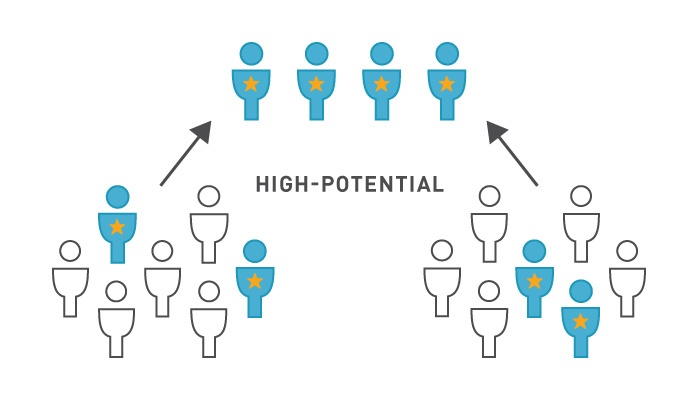3 Essential Elements for Crafting a Thriving High-Potential Initiative
In order to keep top talent in house and maximize bottom-line results, companies must continually re-evaluate and reinvigorate their High Potential development programs. Programs to identify,assess and develop high-potential leaders are mission critical for ensuring long-term growth and success but poorly developed programs with unclear steps can lead to frustration for both the organization as well as the individual:
- The organization: investing time and money in the wrong individuals
- The individual: unclear goals and effort spent with no opportunity
Through our work with clients and external research, we can group the challenges of building and sustaining high-potential programs into 3 areas:
- Selecting the right people
- Developing people
- Establishing accountability for all (e.g., participant, manager(s), and organization)
To help illustrate the frustrations we’ve heard from organizations, which may be the same frustrations you’re experiencing, I’d like to share a story around each area and some tips on how to prevent future frustration.
Selecting the right people
A leading research-based biopharmaceutical company realized its system for grooming front-line managers had a serious defect. Nominees for the company’s Management Development Program (MDP) performed poorly through both the assessment center and training and development opportunities; even more concerning, after completion many participants were not interested in relocating for a promotion. The organization wanted to know what happened, where they went wrong.
After reviewing the company’s current selection process for identifying MDP nominees, we recognized two key problems. The first was limited criteria used for identifying MDP candidates, which needed to include relocation preferences and soft skills. The second obstacle was that MDP nominees were being selected into the program by their boss's boss. At two levels up, sponsors were found to be too far removed from the nominees’ actual day to day activities and responsibilities to effectively evaluate a nominees’ potential. As a result, through no fault of their own, senior leaders were selecting the wrong nominees for the program.
How did they fix it?
- Enhance their definition of a successful front-line manager
- Study the traits of prior successful participants and update the criteria to include the traits that most impact the business
- Review requirements of the next role (i.e. willingness to relocate, travel) and ensure that’s part of the selection criteria
Developing People
About a year ago, a major medical device manufacturer approached The Vaya Group about a dilemma it was having surrounding its Technical Specialist (TS) and Sales Representative (SR) positions. Many SRs started with the company as TSs before assuming responsibility for sales. Because the roles involve many of the same duties—conducting product demonstrations, responding to customer questions, keeping customers abreast of industry developments and developing relationships with medical personnel—the organization thought it was a no-brainer to promote top-performing technical specialists into sales reps.
But as time passed, the company realized the strategy wasn’t working. Although some of the individuals promoted from TS to SR performed well under their new title, many others did not.
How do they develop the new SRs to help them perform well?
- When it comes to developing we’ve found it’s best to focus on 1 or 2 things at a time. Take a targeted development approach that focuses on the highest impact competencies. Compare the assessment results of top sales performers to those of poor sales performers. Identify the competencies that are the difference makers to develop.
- Emphasize on-the-job experiences or experiential learning. Do not put too much emphasis on training, books, and formal learning to develop.
- Don’t wait a year to get or give feedback. Measure the development progress with pulse surveys periodically.
Establishing Accountability for All
This is a story we hear all too often. Johnny went through the high potential development program and now he’s ready to be promoted. Danny went through the high potential development program as well and showed as much promise as Johnny but something changed and he just put in his resignation. Johnny had the good fortune to have a manager who was committed to his development and Johnny had the focus and drive to truly work on his development. Danny had the drive but his manager only focused on the tasks of his current job and didn’t give Danny the opportunities he needed to practice his development.
What should we have done differently with Danny?
- Communicate participant expectations so the participants take charge and “own” their development. This means letting high-potentials know how long they have to complete the program, what tools and resources they can access to further enhance their skill sets and how to track their overall progress.
- Don’t stop at individual accountability. Make sure the manager is involved in the development process and understands their role. Their role may be to ensure the individual has opportunity to practice new skills, check-in with the individual on their progress.
- HR/OD play a key role in monitoring progress, keeping people focused and linking training based on needs
For more information and examples of how other leading companies select the right people, register for our free upcoming webinar - Register Now. This webinar is designed for leadership development professionals who are looking to improve their approach to selecting talent for high-potential programs.






